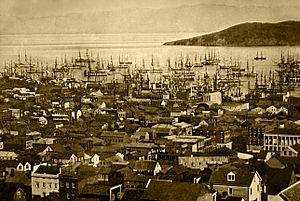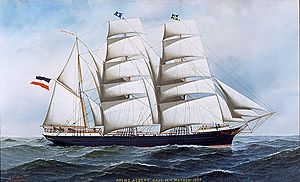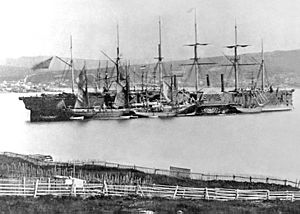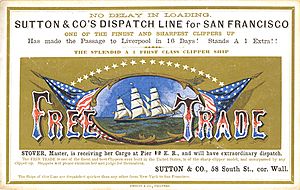Maritime history of the United States (1800–1899) facts for kids
The United States saw a big increase in its activities at sea during the 1800s. This included everything from naval battles to new types of ships and important changes in how people worked on the water. This period was a time of great growth and change for America's connection to the oceans.
Contents
- The War of 1812: A Second Fight for Freedom (1812-1815)
- Changes in Shipping and Trade (1815-1830)
- New Beginnings and Lifesaving Missions (1830s)
- Steamships Connect the Coasts (1840s)
- The Golden Age of Sailing and New Discoveries (1850s)
- Civil War and the Decline of Sail (1860s)
- New Technologies and Worker Rights (1870s)
- Organizing for Change: Unions Emerge (1880s)
- Growing Unions and Sailor Protections (1890s)
The War of 1812: A Second Fight for Freedom (1812-1815)
The United States declared war on Britain on June 18, 1812. This happened for several reasons. Americans were angry because the British navy was stopping their ships and forcing American sailors to join the British navy. This was called "impressment."
Americans were also upset because Britain was limiting their trade with other countries, especially France. On top of that, Britain was supporting Native American tribes who were fighting against American settlers. Even though Britain offered to stop the trade limits, it was too late. Many Americans, known as "War Hawks," saw this as a "second war for independence."
A key part of America's plan was to use hundreds of privateers. These were private ships given permission by the government to attack British merchant ships. This greatly harmed British trade, especially in the West Indies.
Clipper Ships: The Speed Demons of the Sea
The term "clipper" first referred to the Baltimore clipper in the United States. This was a type of fast sailing ship, like a schooner, developed before the American Revolution. During the War of 1812, these ships were lightly armed and used as privateers. They became famous for their amazing speed.
Clippers were built for speed, not for carrying lots of cargo. Regular merchant ships usually sailed at less than 5 knots (9 km/h). Clippers aimed for 9 knots (17 km/h) or more, and sometimes even reached 20 knots (37 km/h)! They were used for goods where getting there fast was important, like tea or spices. They also carried people and mail.
The competition among clipper ships was very public. Their travel times were often reported in newspapers. These fast ships usually didn't last long, often being used for less than 20 years. Because they were so fast and easy to steer, clippers were sometimes used by pirates, privateers, or smugglers.
Changes in Shipping and Trade (1815-1830)
Before the 1800s, ships carrying goods and people between Europe and America would only sail when they were completely full. But as trade grew, having ships leave on a regular schedule became very important.
In 1818, the Black Ball Line started regular trips between Britain and America. These were called "packet ships" because they delivered mail "packets." They were known for sticking to their schedules, but also for treating sailors harshly to make sure they arrived on time. Sailors even called them "bloodboats."
During the 1820s, American whalers began sailing to the Pacific Ocean. This led to more contact with the Hawaiian Islands. Many people from Cape Verde also moved to the U.S., especially to New Bedford, Massachusetts, because of whaling and droughts. This created strong connections and trade routes between New England and Cape Verde.
The Erie Canal was built between 1817 and 1825. This canal helped trade move inland and made New York City a more important port.
New Beginnings and Lifesaving Missions (1830s)
In 1832, a government official named Louis McLane ordered revenue cutters (government ships) to patrol in winter. Their job was to help sailors who were in trouble. In 1837, Congress made this an official rule. This was the start of the lifesaving work that the U.S. Coast Guard would later become famous for.
The SS Great Western was the first steamship built specifically for regular trips across the Atlantic Ocean. It started these trips in 1838.
Steamships Connect the Coasts (1840s)
The first regular steamship service from the west coast to the east coast of the United States began on February 28, 1849. The SS California arrived in San Francisco Bay after a long journey. It had left New York Harbor in October 1848 and sailed around Cape Horn at the tip of South America. The trip took 4 months and 21 days.
The SS Great Eastern was built between 1854 and 1857. It was meant to connect Great Britain with India without needing to stop for coal. This ship had a difficult history and was never used for its original purpose. However, in 1866, it successfully laid the first telegraph cable across the Atlantic Ocean.
The Golden Age of Sailing and New Discoveries (1850s)
Between 1851 and 1852, 74 clipper ships arrived in San Francisco. The average trip around Cape Horn was cut from seven or eight months down to three or four months.

In 1852, the lighthouse board created and published the first Light List and Notice to Mariners. These guides helped sailors navigate safely.
In 1854, Commodore Matthew C. Perry opened trade relations with Japan. This was done by signing the Convention of Kanagawa.
The year 1855 was a peak for American shipbuilding. During this year, 381 ships and barks (types of sailing ships) and 126 brigs (another type of sailing ship) were launched for deep-sea trade.
By 1857, New Bedford, Massachusetts, had 329 whaling ships. But the discovery of petroleum in Titusville, Pennsylvania, in 1859, changed everything. Kerosene, made from crude oil, began to replace whale oil in lamps. This led to the end of commercial whaling in the United States. Later, electricity replaced oil lamps, and by the 1920s, the need for whale oil was gone.
The use of clipper ships began to decline after an economic downturn in 1857. The rise of the steamship also played a big role. While clippers could be faster, steamships could reliably keep to a schedule, no matter the wind. Some ships, called "steam clippers," even had extra steam engines to use when there was no wind.
In 1859, the "Memphis and St. Louis Packet Line" was formed. This company, later known as the Anchor Line, operated steamboats on the Mississippi River until 1898.
Civil War and the Decline of Sail (1860s)
In 1861, the American merchant marine (all the commercial ships) was the second largest in the world. It had over 5.5 million tons of shipping, just slightly less than Great Britain's 5.8 million tons.
Merchant shipping became a major target during the American Civil War. For example, the CSS CSS Alabama, a Confederate cruiser, spent months capturing and burning Union ships. Other Confederate ships like the CSS Sumter, CSS Florida, and CSS Shenandoah also attacked merchant vessels.
The final blow to clipper ships came with the opening of the Suez Canal in 1869. This canal created a huge shortcut for steamships traveling between Europe and Asia. However, it was very difficult for sailing ships to use.
New Technologies and Worker Rights (1870s)
By 1870, new inventions like the screw propeller and the triple expansion engine made shipping across oceans much cheaper and safer. This marked the beginning of easier global travel and trade.
Starting in 1873, ship officers had to pass a required exam to get their licenses.
In 1874, a union that would become the Marine Engineers' Beneficial Association (MEBA) was formed. This group brought together marine engineers from different cities to work for their rights. The MEBA was officially formed on February 25, 1875.
By 1876, Plimsoll marks became required on all U.S. vessels. These marks show how much a ship can be safely loaded.
Organizing for Change: Unions Emerge (1880s)
The Sailors' Union of the Pacific (SUP) was founded on March 6, 1885, in San Francisco. This was a labor union for sailors, fishermen, and boatmen working on U.S. ships.
Andrew Furuseth, a key figure in maritime labor, joined the union in 1885 and later became its secretary.
The American Federation of Labor (AFL) was founded in 1886 by Samuel Gompers. It was a national group of skilled workers' unions. Several maritime unions later joined the AFL.
In 1887, the Merchant Marine and Fisheries Committee was formed. This government committee focused on issues related to shipping and fishing.
Growing Unions and Sailor Protections (1890s)
In 1891, a school for marine engineering opened in Massachusetts.
Also in 1891, Andrew Furuseth helped merge two sailor unions to form the Sailors' Union of the Pacific. Furuseth served as the union's secretary for many years.
In 1892, the National Union of Seamen of America was formed in Chicago. This was a group of independent unions, including the Sailors' Union of the Pacific. In 1893, this organization joined the American Federation of Labor. In 1895, it changed its name to the International Seamen's Union of America.
Important laws were passed to protect sailors. The Maguire Act of 1895 meant that sailors could no longer be jailed for leaving a ship in coastal waters. The White Act of 1898 went even further, ending imprisonment for U.S. citizens who left ships in American or nearby waters. It also stopped physical punishment of sailors.
|




